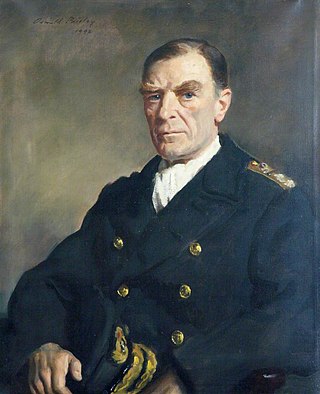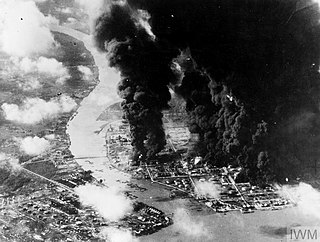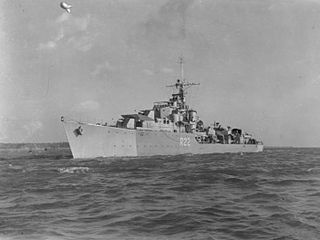
HMS Victorious was the third Illustrious-class aircraft carrier after Illustrious and Formidable. Ordered under the 1936 Naval Programme, she was laid down at the Vickers-Armstrong shipyard at Newcastle upon Tyne in 1937 and launched two years later in 1939. Her commissioning was delayed until 1941 due to the greater need for escort vessels for service in the Battle of the Atlantic.

HMS Indomitable was a modified Illustrious-class aircraft carrier built for the Royal Navy during World War II. Originally planned to be the fourth of the class, she was redesigned to enable her to operate more aircraft, 48 instead of 36. A second hangar was added above the original, raising the flight deck by 14 feet (4.3 m), although the hangar-side armour had to be reduced to compensate. The lower hangar was made shorter than the upper hangar due to the need for extra workshops and accommodation to support the added aircraft.

The British Pacific Fleet (BPF) was a Royal Navy formation that saw action against Japan during the Second World War. It was formed from aircraft carriers, other surface warships, submarines and supply vessels of the RN and British Commonwealth navies in November 1944.

Admiral of the Fleet Sir Philip Louis Vian, & Two Bars was a Royal Navy officer who served in both World Wars.

HMS Euryalus was a Dido-class cruiser of the Royal Navy. She was laid down at Chatham Dockyard on 21 October 1937, launched on 6 June 1939, and commissioned 30 June 1941. Euryalus was the last cruiser built at the dockyard.

849 Naval Air Squadron was a squadron of the Fleet Air Arm, the Air Arm of the British Royal Navy. It was formed during the Second World War as a carrier based torpedo-bomber, unit, flying missions against Japanese targets in the Far East. Its service since the Second World War has been as an airborne early warning squadron, flying fixed winged Skyraiders and Gannets from the Royal Navy's fixed wing carriers from 1952 until 1978, and airborne early warning Sea King helicopters from 1982 to 2018.

Operation Cockpit was an Allied attack against the Japanese-held island of Sabang on 19 April 1944. It was conducted by aircraft flying from British and American aircraft carriers and targeted Japanese shipping and airfields. A small number of Japanese ships and aircraft were destroyed, and one American aircraft was lost. While the attack was successful tactically, it failed to divert Japanese forces from other areas as had been hoped.

Operation Inmate was an attack by the British Pacific Fleet against Japanese positions on Truk Atoll in the central Pacific Ocean during the Second World War. The attacks against the isolated islands on 14 and 15 June 1945 were conducted to provide combat experience for the aircraft carrier HMS Implacable and several of the fleet's cruisers and destroyers ahead of their involvement in more demanding operations off the Japanese home islands.

Operation Meridian, also known as the "Palembang Raids" was part of a series of British air attacks directed at Japanese-held oil refineries near Palembang on Sumatra during the Second World War, Meridian had two phases: Meridian I on 24 January 1945 and Meridian II on 29 January. As a result, the critical aviation fuel output of the plants at Palembang was reduced by seventy-five percent.

HMS Roebuck was an R-class destroyer of the British Royal Navy that saw service during World War II. She was the fifteenth ship to carry this traditional ship name, after a small deer native to the British Isles, which was used as far back as the reign of Queen Elizabeth I.

HMS Undine was a U-class destroyer of the British Royal Navy that saw service during World War II. On 27 March 1945, HMS Undine detached from RN Fast Carrier TF57 to rescue the airmen of a downed RN TBF Avenger aircraft also rescued a USN Corsair pilot adrift for two days south of the Sakishima Gunto in the Philippine Sea.

HMS Ursa was a U-class destroyer of the Royal Navy that saw service during the Second World War. She was later converted into a Type 15 fast anti-submarine frigate, with the new pennant number F200.

The Battle of Palembang was a battle of the Pacific theatre of World War II. It occurred near Palembang, on Sumatra, on 13–15 February 1942. The Royal Dutch Shell oil refineries at nearby Plaju were the major objectives for the Empire of Japan in the Pacific War, because of an oil embargo imposed on Japan by the United States, the Netherlands, and the United Kingdom after the Japanese invaded China. With the area's abundant fuel supply and airfield, Palembang offered significant potential as a military base to both the Allies and the Japanese.

HMS Wessex was one of eight W-class destroyers built for the Royal Navy during World War II. Completed in 1944, the ship spent most of the war assigned to the Eastern and Pacific Fleets. She screened British aircraft carriers as their aircraft attacked targets in the Japanese-occupied Nicobar Islands, the Dutch East Indies and Okinawa.

HMS Kempenfelt was a W-class destroyer flotilla leader of the Royal Navy that served in the Second World War. She was the second destroyer of her name to have served in the war; the first Kempenfelt was transferred to the Royal Canadian Navy in October 1939 and renamed HMCS Assiniboine.

HMS Whelp was one of eight W-class destroyers built for the Royal Navy during the Second World War. Completed in 1944, the ship spent most of the war assigned to the Eastern and Pacific Fleets. She screened British aircraft carriers as their aircraft attacked targets in the Japanese-occupied Nicobar Islands, the Dutch East Indies, Formosa and near Okinawa. Whelp was present at the Japanese surrender in Tokyo Bay in 1945 and later in Hong Kong. She was paid off in January 1946 and went into reserve.

The Eastern Fleet, later called the East Indies Fleet, was a fleet of the Royal Navy which existed between 1941 and 1952.
Operation Balsam was a British naval operation in World War II, from 10–20 June 1945, under the command of Commodore Geoffrey Oliver. The third in a string of similar missions, the objectives were the naval bombardment and aerial strikes on Japanese airfields in Sumatra, Japanese vessels in the Strait of Malacca, and aerial reconnaissance.
Operation Robson was the first of a series of aerial operations, Operation Outflank, undertaken by the British Pacific Fleet (BPF) against the oil refineries of Japanese-occupied Sumatra during World War II. Admiral Chester Nimitz, Commander in Chief, Pacific Ocean Areas, proposed a strike on the refineries to Admiral Bruce Fraser, commander of the BPF, during a meeting in early December.

The destroyer HNLMS Tjerk Hiddes was a British built, Dutch warship of World War II. She was laid down on 22 May 1940 as a British N-class destroyer and launched on 25 June 1941 as HMS Nonpareil, but on 27 May 1942, she was transferred to the Royal Dutch Navy. The ship was commissioned in 1942 as HNLMS Tjerk Hiddes, named after the 17th century Dutch admiral, Tjerk Hiddes de Vries. Much of her war service was with the Royal Navy and United States Navy in the Indian Ocean and Australia. Following the war, the destroyer was sold to Indonesia and renamed RI Gadjah Mada. She was scrapped in 1961.


















